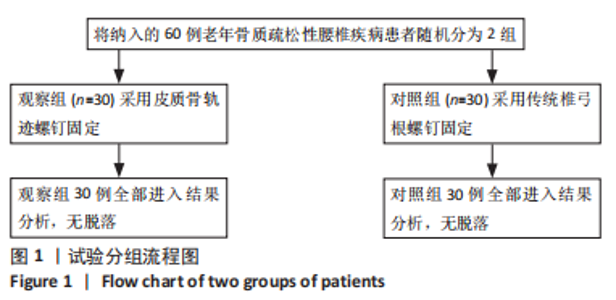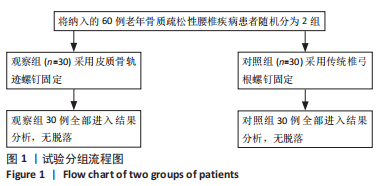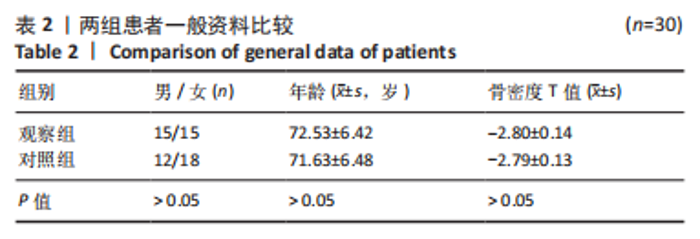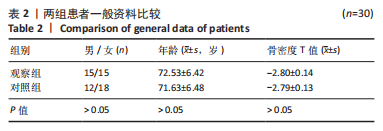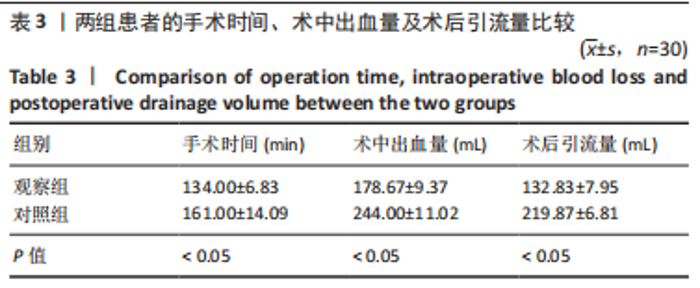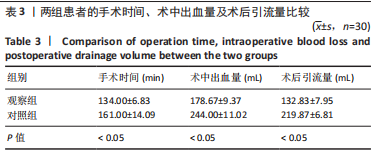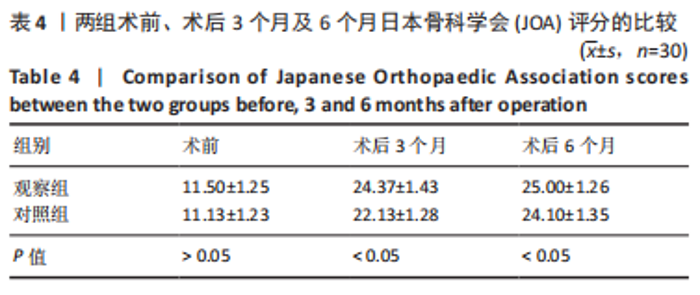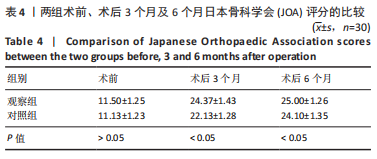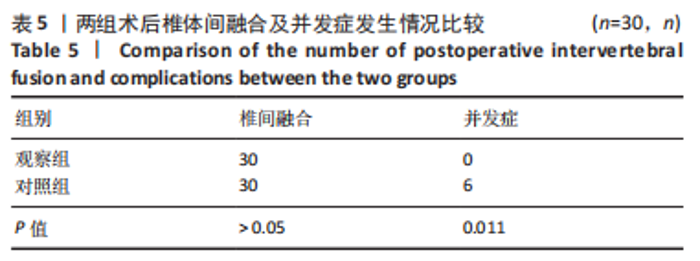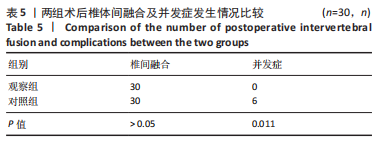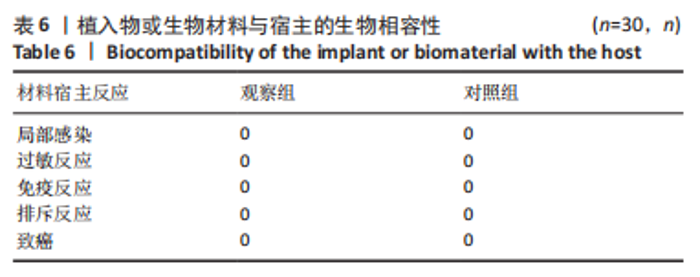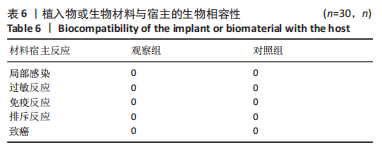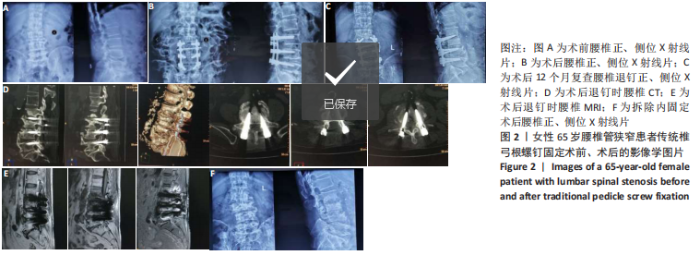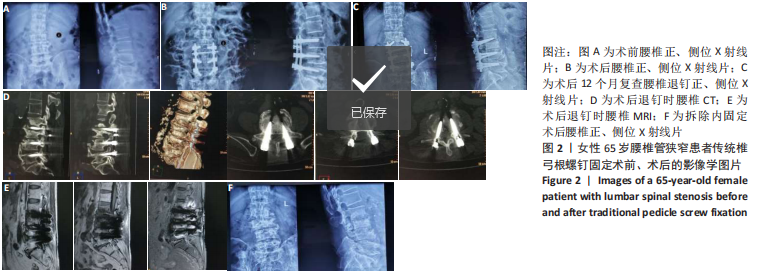Chinese Journal of Tissue Engineering Research ›› 2022, Vol. 26 ›› Issue (3): 403-407.doi: 10.12307/2022.066
Previous Articles Next Articles
Cortical bone trajectory in elderly patients with osteoporosis of lumbar disease
Cai Feng, Yu Bo, Zeng Duo, Chen Qincan, Liao Qi
- Third Affiliated Hospital of Nanchang University, Nanchang 330000, Jiangxi Province, China
-
Received:2021-01-25Revised:2021-01-27Accepted:2021-03-04Online:2022-01-28Published:2021-10-27 -
Contact:Chen Qincan, Master candidate, Third Affiliated Hospital of Nanchang University, Nanchang 330000, Jiangxi Province, China Liao Qi, Master, Professor, Master’s supervisor, Third Affiliated Hospital of Nanchang University, Nanchang 330000, Jiangxi Province, China -
About author:Cai Feng, Master, Attending physician, Third Affiliated Hospital of Nanchang University, Nanchang 330000, Jiangxi Province, China -
Supported by:the Science and Technology Plan of Jiangxi Health Commission, No. 20202007 (to CF)
CLC Number:
Cite this article
Cai Feng, Yu Bo, Zeng Duo, Chen Qincan, Liao Qi. Cortical bone trajectory in elderly patients with osteoporosis of lumbar disease[J]. Chinese Journal of Tissue Engineering Research, 2022, 26(3): 403-407.
share this article
Add to citation manager EndNote|Reference Manager|ProCite|BibTeX|RefWorks
| [1] BRAYDA-BRUNO M, TIBILETTI M, ITO K, et al. Advances in the diagnosis of degenerated lumbar discs and their possible clinical application. Eur Spine J. 2014;23 Suppl 3:S315-S323. [2] OMIDI-KASHANI F, HASANKHANI EG, ASHJAZADEH A. Lumbar spinal stenosis: who should be fused? An updated review. Asian Spine J. 2014;8(4):521-530. [3] REXITI P, AIERKEN G, WANG S, et al. Anatomical research on strength of screw track fixation in novel cortical bone trajectory for osteoporosis lumbar spine. Am J Transl Res.2019;11(11):6850-6859. [4] SANTONI BG, HYNES RA, MCGILVRAY KC, et al. Cortical bone trajectory for lumbar pedicle screws. Spine J. 2009;9(5):366-373. [5] LEE GW, AHN MW. Comparative Study of Cortical Bone Trajectory-Pedicle Screw (Cortical Screw) Versus Conventional Pedicle Screw in Single-Level Posterior Lumbar Interbody Fusion: A 2-Year Post Hoc Analysis from Prospectively Randomized Data. World Neurosurg. 2018;109:e194-e202. [6] 刘玉增,海涌,张希诺,等. 皮质骨轨迹螺钉固定与椎弓根螺钉固定在腰椎后路融合术中的疗效[J]. 中华医学杂志,2019,99(19):1473-1478. [7] WEISER L, HUBER G, SELLENSCHLOH K, et al. Insufficient stability of pedicle screws in osteoporotic vertebrae: biomechanical correlation of bone mineral density and pedicle screw fixation strength. Eur Spine J. 2017;26(11):2891-2897. [8] EL SA, MEIER S, SANDER A, et al. Reduced loosening rate and loss of correction following posterior stabilization with or without PMMA augmentation of pedicle screws in vertebral fractures in the elderly. Eur J Trauma Emerg Surg. 2013;39(5): 455-460. [9] REXITI P, AIERKEN G, WANG S, et al. Anatomical research on strength of screw track fixation in novel cortical bone trajectory for osteoporosis lumbar spine. Am J Transl Res. 2019;11(11):6850-6859. [10] SOSHI S, SHIBA R, KONDO H, et al. An experimental study on transpedicular screw fixation in relation to osteoporosis of the lumbar spine. Spine (Phila Pa 1976). 1991;16(11):1335-1341. [11] GAO H, ZHANG R, JIA C, et al. Novel Placement of Cortical Bone Trajectory Screws in the Lumbar Spine: A Radiographic and Cadaveric Study. Clin Spine Surg. 2018;31(6):E329-E336. [12] SKINNER R, MAYBEE J, TRANSFELDT E, et al. Experimental pullout testing and comparison of variables in transpedicular screw fixation. A biomechanical study. Spine (Phila Pa 1976). 1990;15(3):195-201. [13] REXITI P, AIERKEN G, WANG S, et al. Anatomical research on strength of screw track fixation in novel cortical bone trajectory for osteoporosis lumbar spine. Am J Trans Res. 2019;11(11):6850-6859. [14] WILKES RA, MACKINNON JG, THOMAS WG. Neurological deterioration after cement injection into a vertebral body. J Bone Joint Surg Br. 1994;76(1):155. [15] LI HM, ZHANG RJ, GAO H, et al. Biomechanical Fixation Properties of the Cortical Bone Trajectory in the Osteoporotic Lumbar Spine. World Neurosurg. 2018;119:e717-e727 [16] MAI HT, MITCHELL SM, HASHMI SZ, et al. Differences in bone mineral density of fixation points between lumbar cortical and traditional pedicle screws. Spine J. 2016;16(7):835-841. [17] MATSUKAWA K, YATO Y, KATO T, et al. In vivo analysis of insertional torque during pedicle screwing using cortical bone trajectory technique. Spine (Phila Pa 1976). 2014;39(4):E240-E245. [18] MOBBS RJ. Differences in bone mineral density between cortical bone trajectory and traditional lumbar pedicle screws: commentary. Spine J. 2016;16(7):842. [19] TAKENAKA S, MUKAI Y, TATEISHI K, et al. Clinical Outcomes After Posterior Lumbar Interbody Fusion: Comparison of Cortical Bone Trajectory and Conventional Pedicle Screw Insertion. Clin Spine Surg. 2017;30(10):E1411-E1418. [20] SAKAURA H, MIWA T, YAMASHITA T, et al. Posterior lumbar interbody fusion with cortical bone trajectory screw fixation versus posterior lumbar interbody fusion using traditional pedicle screw fixation for degenerative lumbar spondylolisthesis: a comparative study. J Neurosurg Spine. 2016;25(5):591-595. [21] WANG J, HE X, SUN T. Comparative clinical efficacy and safety of cortical bone trajectory screw fixation and traditional pedicle screw fixation in posterior lumbar fusion: a systematic review and meta-analysis. Eur Spine J. 2019;28(7):1678-1689. [22] CHIN KR, PENCLE F, COOMBS AV, et al. Clinical Outcomes With Midline Cortical Bone Trajectory Pedicle Screws Versus Traditional Pedicle Screws in Moving Lumbar Fusions From Hospitals to Outpatient Surgery Centers. Clin Spine Surg. 2017;30(6):E791-E797. [23] CHEN Y, DEB S, JABARKHEEL R, et al. Minimally Invasive Lumbar Pedicle Screw Fixation Using Cortical Bone Trajectory: Functional Outcomes. Cureus. 2018;10(10):e3462. [24] 王海峰,曾忠友,金辉. 后路腰椎椎间融合术中使用皮质骨轨迹螺钉或椎弓根螺钉治疗腰椎退行性疾病[J]. 脊柱外科杂志,2020,18(1):53-57. [25] 付荣华,耿晓鹏,付国勇,等. 椎弓根皮质骨通道与常规通道螺钉治疗骨质疏松性腰椎疾病[J]. 中国矫形外科杂志,2020,28(5):405-410 [26] ZHANG L, TIAN N, YANG J, et al. Risk of pedicle and spinous process violation during cortical bone trajectory screw placement in the lumbar spine. BMC Musculoskelet Disord. 2020;21(1):536. [27] NAMBA RS, INACIO MC, PAXTON EW. Risk factors associated with deep surgical site infections after primary total knee arthroplasty: an analysis of 56,216 knees. J Bone Joint Surg Am. 2013;95(9):775-782. [28] OKUDA S, NAGAMOTO Y, MATSUMOTO T, et al. Adjacent Segment Disease After Single Segment Posterior Lumbar Interbody Fusion for Degenerative Spondylolisthesis: Minimum 10 Years Follow-up. Spine (Phila Pa 1976). 2018;43(23):E1384-E1388. [29] SAKAURA H, IKEGAMI D, FUJIMORI T, et al. Early cephalad adjacent segment degeneration after posterior lumbar interbody fusion: a comparative study between cortical bone trajectory screw fixation and traditional trajectory screw fixation. J Neurosurg Spine. 2019;32(2):155-159. [30] KIM HJ, CHUN HJ, KANG KT, et al. The biomechanical effect of pedicle screws’ insertion angle and position on the superior adjacent segment in 1 segment lumbar fusion. Spine (Phila Pa 1976). 2012;37(19):1637-1644. |
| [1] | Yuan Jiabin, Zhu Zongdong, Tang Xiaoming, Wei Dan, Tan Bo, Xiao Chengwei, Zhao Ganlinwei, Liao Feng. Classification and reduction strategies for irreducible intertrochanteric femoral fracture based on anatomy [J]. Chinese Journal of Tissue Engineering Research, 2022, 26(9): 1341-1345. |
| [2] | Pan Baoshun, Fang Zhen, Gao Mingjie, Fang Guiming, Chen Jinshui. Design for posterior atlantoaxial internal fixation system with fusion cage based on imaging data [J]. Chinese Journal of Tissue Engineering Research, 2022, 26(9): 1372-1376. |
| [3] | Li Kun, Gao Erke, Xiong Feng, Wang Xing, Wu Danqi, Li Zhijun, Zhang Shaojie, Liu Yanan, Duo Lan, Li Ziyu. Feasibility of axial transpedicle screw internal fixation in children aged 1 to 6 years [J]. Chinese Journal of Tissue Engineering Research, 2022, 26(9): 1383-1387. |
| [4] | Jiang Huanchang, Zhang Zhaofei, Liang De, Jiang Xiaobing, Yang Xiaodong, Liu Zhixiang. Comparison of advantages between unilateral multidirectional curved and straight vertebroplasty in the treatment of thoracolumbar osteoporotic vertebral compression fracture [J]. Chinese Journal of Tissue Engineering Research, 2022, 26(9): 1407-1411. |
| [5] | Zhu Chan, Han Xuke, Yao Chengjiao, Zhou Qian, Zhang Qiang, Chen Qiu. Human salivary components and osteoporosis/osteopenia [J]. Chinese Journal of Tissue Engineering Research, 2022, 26(9): 1439-1444. |
| [6] | Li Wei, Zhu Hanmin, Wang Xin, Gao Xue, Cui Jing, Liu Yuxin, Huang Shuming. Effect of Zuogui Wan on bone morphogenetic protein 2 signaling pathway in ovariectomized osteoporosis mice [J]. Chinese Journal of Tissue Engineering Research, 2022, 26(8): 1173-1179. |
| [7] | Xiao Hao, Liu Jing, Zhou Jun. Research progress of pulsed electromagnetic field in the treatment of postmenopausal osteoporosis [J]. Chinese Journal of Tissue Engineering Research, 2022, 26(8): 1266-1271. |
| [8] | Gao Yujin, Peng Shuanglin, Ma Zhichao, Lu Shi, Cao Huayue, Wang Lang, Xiao Jingang. Osteogenic ability of adipose stem cells in diabetic osteoporosis mice [J]. Chinese Journal of Tissue Engineering Research, 2022, 26(7): 999-1004. |
| [9] | Yang Jun, Yang Qun, Zhang Rui, Jiang Chang. A novel slidable pedicle screw-rod system for lumbar tuberculosis: promoting bone graft fusion by producing stress stimulation to fused segment [J]. Chinese Journal of Tissue Engineering Research, 2022, 26(6): 914-918. |
| [10] | Zhang Xinlong, Ci Wentao, Luo Kaiwen, Yan shi. Internal fixation failure after proximal femoral nail antirotation: causes and reoperation strategies [J]. Chinese Journal of Tissue Engineering Research, 2022, 26(6): 973-979. |
| [11] | Peng Kun. Improvement of the treatment effect of osteoporotic fractures: research status and strategy analysis [J]. Chinese Journal of Tissue Engineering Research, 2022, 26(6): 980-984. |
| [12] | Shen Song, Xu Bin. Diffuse distribution of bone cement in percutaneous vertebroplasty reduces the incidence of refracture of adjacent vertebral bodies [J]. Chinese Journal of Tissue Engineering Research, 2022, 26(4): 499-503. |
| [13] | Ou Liang, Kong Dezhong, Xu Daoqing, Ni Jing, Fu Xingqian, Huang Weichen. Comparative clinical efficacy of polymethyl methacrylate and self-solidifying calcium phosphate cement in vertebroplasty: a meta-analysis [J]. Chinese Journal of Tissue Engineering Research, 2022, 26(4): 649-656. |
| [14] | Li Yanting, Chen Jian, Liu Menglan, Ren Manman, Zhong Weihong, Chen Changxing. Three-dimensional finite element analysis of Daogaijinbei manipulation on lumbar intervertebral disc biomechanics [J]. Chinese Journal of Tissue Engineering Research, 2022, 26(3): 340-343. |
| [15] | Liang Haoran, Zhou Xin, Yang Yanfei, Niu Wenjie, Song Wenjie, Ren Zhiyuan, Wang Xueding, Liu Yang, Duan Wangping. Pathogenesis of femoral head necrosis after internal fixation of femoral neck fractures in young adults [J]. Chinese Journal of Tissue Engineering Research, 2022, 26(3): 456-460. |
| Viewed | ||||||
|
Full text |
|
|||||
|
Abstract |
|
|||||
